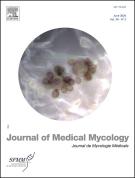First case of neonatal fungemia caused by Aureobasidium melanogenum - 17/03/23
 , Anuradha Sharma 1
, Anuradha Sharma 1Abstract |
Aureobasidium melanogenum is a saprophytic, dematiaceous, yeast-like fungus rarely implicated in human infections. Here, we report the first case of A. melanogenum fungemia in a 30-week-old preterm, very low birth weight neonate born to a primigravida with history of gestational diabetes, pregnancy induced hypertension and oligohydramnios. The baby developed respiratory distress, hypotension, bradycardia, coagulopathy and septic shock shortly after birth, and eventually succumbed to multiple organ dysfunction syndrome on day 9 of life. Paired blood culture showed growth of a dematiaceous yeast-like fungus which was identified as A. melanogenum by rDNA internal transcribed spacer (ITS) sequencing. Antifungal susceptibility testing of the isolate showed high minimum inhibitory concentration of fluconazole (32 µg/mL), indicating resistance. Diagnosis of A. melanogenum fungemia is difficult as it is easily confused with Candida species in Gram stained smears and similar colony morphology during the initial stages of growth. Also, the conventional diagnostic methods, such as VITEK 2 and MALDI-TOF MS are unreliable for identification of this pathogen. Accurate identification using molecular techniques is crucial for making treatment decisions as A. melanogenum shows substantial antifungal resistance. Clinicians should be aware that yeast-like cells in blood culture are not only indicative of Candida species, but also rare pathogens like A. melanogenum and should exercise caution while starting fluconazole therapy. At present, there are no established susceptibility breakpoints for Aureobasidium spp. Further studies are needed to determine the optimal treatment for such infections.
Le texte complet de cet article est disponible en PDF.Keywords : Aureobasidium melanogenum, Fungemia, Catheter-related bloodstream infection, Neonatal sepsis, Amphotericin B, Internal transcribed spacer
Plan
Vol 33 - N° 1
Article 101334- mars 2023 Retour au numéroBienvenue sur EM-consulte, la référence des professionnels de santé.
L’accès au texte intégral de cet article nécessite un abonnement.
Déjà abonné à cette revue ?

